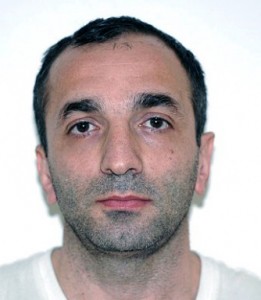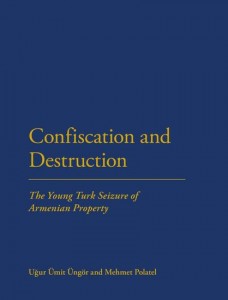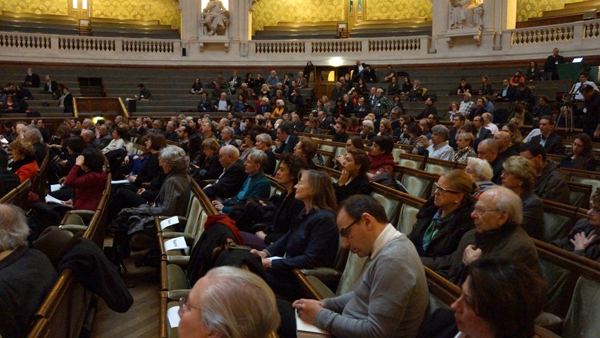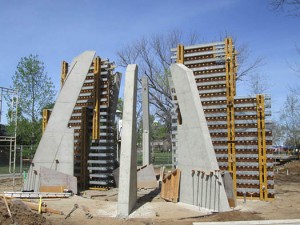By Taleen Babayan
Scholars from around the world participated in an in-depth and timely academic conference, “Monuments and Memory,” focusing on buildings and material culture in the aftermath of mass violence, with a special consideration on the ruins of the medieval city of Ani in eastern Turkey, on Friday, February 20, at Columbia’s School of International and Public Affairs in a standing-room only event spearheaded by Professors Peter Balakian and Rachel Goshgarian.
The all-day symposium commenced with the initial session, “Monuments and Memory: The Significance of Material Culture in the Aftermath of Genocide,” which was moderated by Christine Philliou, Associate Professor of History, Columbia University, and featured Peter Balakian, Donald M. Constance H. Rebar Professor of the Humanities, Colgate University; Marianne Hirsch, William Peterfield Trent Professor of English and Comparative Literature at Columbia University and Professor in the Institute for Research on Women, Gender and Sexuality; and Andrew Herscher, Associate Professor at the University of Michigan.
Hirsch elaborated on monumental memory, which sustains collective memory, and the mobilization of history through these monuments on sites of destruction. She touched on how public memory has responded with exhibitions, including two major ones in Paris about the liberation during the Second World War, as well as a year of new museums built on destruction sites, such as the 9/11 Memorial Museum in New York.
“Museums have the capacity to be agents of transformation,” said Hirsch, who noted that memorial museums bring the past into the present. “The museum is performing a series of small acts of repair.”
Herscher spoke about genocide as counter-memory and the politics of the counter-monument. He cited the “Memorial in Exile” of the Bosnian War that was unveiled at the 2012 Summer Olympic Park in London, which was a counter-monument to the removal of all traces of violence by Bosnian Serbs soldiers in the 1990s in Republika Srpska. He noted that in Germany in the 1980s, Holocaust memorials were being imagined and commissioned and that they “defied ambitions of permanence, durability and visibility.”
“These new monuments were designed to disappear, not be visible,” said Herscher, adding that violence was culturally productive. “Memory is a prime act of consciousness.”
Focusing on Grigoris Balakian’s “The Ruins of Ani” published in 1910, Peter Balakian discussed the history of Ani depicted in G. Balakian’s book, which he said shed light on Armenian intellectual thinking of the time. According to G. Balakian, the churches of Ani were foundations of gothic architecture in Europe and were of the highest artistic merit. Peter Balakian noted that Ani is today a place of cultural destruction and Turkey needs to tend to this issue, which could be the beginning of some restitution.
“The current situation creates another post-genocidal trauma,” said Balakian.
Balakian argued for a revaluation of the present situation of Ani through a post-colonial lens and asserted that, “Armenians remain indigenous to the region.”
The second session of the symposium focused on “The Medieval Armenian City of Ani: A Case Study in the Politicization of Art History, History, Historical Monuments and Preservation in a Post-Genocide Context,” moderated by Nanor Kebranian, Assistant Professor of Middle East South Asian and African Studies, Columbia University.
Christina Maranci, Arthur H. Dadian and Ara Oztemel Chair of Armenian Art and Architectural History at Tufts University, spoke about memory and medieval architecture in Ani. She noted the similarities of the Zvartnots and Garkashen churches and that Zvartnots represents “a creative fusion of traditions from Syria and the Holy Land.”
She mentioned that medieval accounts of Zvartnots praised the structure and although it was dedicated to St. Gregory, it showcased a specialized and localized artisanship. There was “careful observation of material past in an effort to preserve it if by reproduction.”
Heghnar Watenpaugh, Associate Professor of Art History, University of California, Davis, elaborated on the politics of cultural heritage at Ani. Providing background on the historical city, she said Ani flourished in the 10th and 11th centuries when it became the capital of the Armenian kingdom, but it was deserted by the 18th century. She noted Ani is one of Turkey’s more “strenuous” tourist sites and the ancient city’s history is sparingly mentioned, instead it is downplayed in the signage. She raised a concern among preservation activists of the intentional removal of crosses by the Turkish Ministry of Culture to erase signs of Christian Armenia presence in Anatolia. A new phase began in 2006, where academics devised a new plan of Ani and dialogue began to emerge between Armenian and Turkey.
“Ani is a cultural bridge between Armenians and Turkey,” said Watenpaugh. “Ani diplomacy reinforces the notion that cultural heritage and politics are intertwined.”
Rachel Goshgarian, Assistant Professor of History at Lafayette College, spoke about Armenian structures and the people who lived or are living with them in and around Ani. She noted that the Kars Church remains in the center of the city but it was converted into a mosque very early on while other area monuments have been neglected, destroyed or repurposed. The World Monument Fund, a New York-based non-profit organization dedicated to preserving and protecting endangered ancient and historic sites around the world, is working with the Turkish Ministry of Culture to encourage more attention be paid to these Armenian monuments.
“Another important voice that needs to be engaged in the conversation are the local people who interact with these monuments every day,” said Goshgarian, who questioned what these structures mean to people on the ground, who interact with these monuments on a daily basis.
“Individuals who live with these buildings may not understand the visual language of the structures but they have repurposed, restructured the sites and they have their own memories of the places as well,” said Goshgarian.
Yavuz Ozkaya, restoration architect and founder of PROMET, who has worked on the preservation of historical sites around Turkey, said that Ani is a unique site with great challenges. He gave a summary of projects in Ani, in particular the Church of St. Gregory of Tigrant Honents, the Church of the Holy Redeemer, and the Mosque of Minuchir, and the major challenges that were faced, such as making the roofs functional. He showed historical surveys and drawings of the reconstruction efforts, along with the World Monuments Fund and the Turkish Ministry of Culture.
The final session, “Monuments, Memory, Restitution, and Social Justice: What issues do monuments raise in these historical contexts? How can social justice and restitution be achieved decades after the event of genocide or mass-killing?” was moderated by Hamid Dabashi, Hagop Kevorkian Professor of Iranian Studies and Comparative Literature at Columbia University.
Leo Spitzer, K.T. Vernon Professor of History Emeritus and Research Professor at Dartmouth College, discussed connective memories, dreams, and journeys of return. He spoke about the power and persistence of attachments to an idea of a city and the “reconstitution to a place that draws on nostalgic and traumatic memories.”
“Persecution, displacement, war, refugee emigrants and post-generation carry open wounds that entail needs for repair, desires for re-establishment with past or physically undertaken journeys of return,” said Spitzer.
He noted that memories are not re-connective but collective, and the abundance of informative materials, such as a collective digital archive containing family photo histories, documents and postcards, have been central factors in creating richer and more detailed landscapes of memory, fostering “a sense of community and group identity.”
Osman Kavala, Founder of Anadolu Kultur, a non-profit company based in Istanbul, whose mission is to build bridges among different ethnic, religious and regional groups, spoke about unearthing Anatolia’s Armenian heritage. He discussed the minority status given to non-Muslims following the Lausanne treaty post World War I, resulting in a “stigma” among the citizens. He added that the “spirit of conquest is an inseparable component of Ottoman history.” He noted recent positive developments including Turkey’s efforts to restore Armenian heritage sites and talks between the two countries.
Elazar Barkan, Professor of International and Public Affairs at Columbia University, spoke about cultural heritage and historical dialogue as a form of restitution. He also discussed the widespread devastation as a result of local war, which creates another form of destruction inflicted through archaeology – excavating one culture over another.
“Changing culture and heritage in post-conflict reconstruction is physical construction of a new identity,” said Barkan. “There is very little restoration after conflict.”
He said it is a positive step that churches are renovated with the aim of “exhibiting tourism and tolerance.” He said progress has been made in Ani and people are taking on greater involvement with conflict resolution and “engaging in the legacy of cultural heritage.”
“Advocacy and scholarship aims to narrow the scope of perspective of past violence and the knowledge of history to resolve the conflict,” said Barkan.
The program concluded with a question and answer session, which included the participation of all of the conference speakers.
“This conference took the discourse about the Armenian past in Turkey to some new places and the voice of Turkish presenters was very important,” said Balakian. “The mix of scholarly voices was unusual and unique, from medieval Ottomantists to contemporary restoration specialists, resulting in an intensely engaged and focused audience.”
Added Watenpaugh, “The legacy of the destruction of cultural heritage as a critical aspect of war, ethnic cleansing and genocide underscored the conference and the destruction of Armenian life in Anatolia is being responded to through important work of reconstruction of religious and historical sites in Eastern Anatolia.”
“The Armenian Center is proud to have hosted this world-class gathering of scholars,” said Dr. Nicole Vartanian, vice chair of The Armenian Center at Columbia University. “The conference explored issues that incorporated myriad disciplines and perspectives, and produced the kind of engaging dialogue that we aimed to facilitate among our panelists and participants. We are grateful to our fellow board members, Professors Balakian and Goshgarian, for bringing this caliber of programming to Columbia University vis-Ã -vis the Armenian Center.”
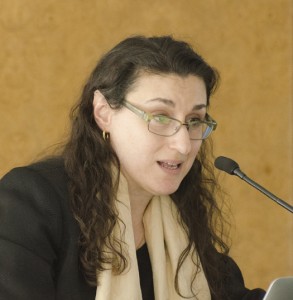 Heghnar Watenpaugh speaking about the politics and cultural heritage of Ani
Heghnar Watenpaugh speaking about the politics and cultural heritage of Ani
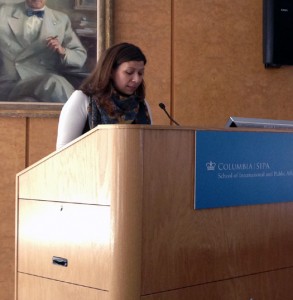 Rachel Goshgarian discussing the Armenian structures and people of Ani
Rachel Goshgarian discussing the Armenian structures and people of Ani
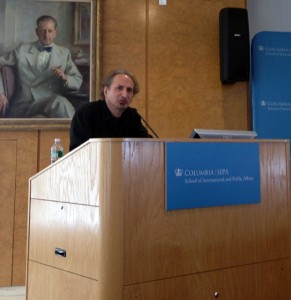 Peter Balakian elaborating on Grigoris Balakian’s The Ruins of Ani
Peter Balakian elaborating on Grigoris Balakian’s The Ruins of Ani
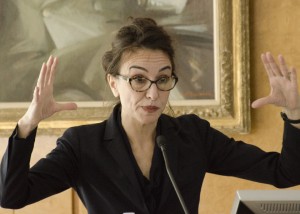 Christina Maranci speaking about memory and medieval architecture at Ani
Christina Maranci speaking about memory and medieval architecture at Ani
Groundbreaking Conference at Columbia University Highlights Monuments and Memory, Ancient City of Ani
